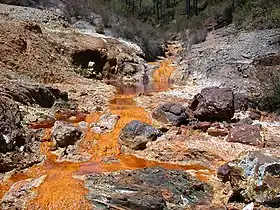| Leptospirillum ferriphilum | |
|---|---|
| Scientific classification | |
| Domain: | Bacteria |
| Phylum: | Nitrospirota |
| Class: | Nitrospira |
| Order: | Nitrospirales |
| Family: | Nitrospiraceae |
| Genus: | Leptospirillum |
| Species: | L. ferriphilum |
| Binomial name | |
| Leptospirillum ferriphilum Coram & Rawlings, 2002 | |
Leptospirillum ferriphilum is an iron-oxidising bacterium able to exist in environments of high acidity, high iron concentrations, and moderate to moderately high temperatures.[1] It is one of the species responsible for the generation of acid mine drainage[2] and the principal microbe used in industrial biohydrometallurgy processes to extract metals.[3]
Taxonomy
L. ferriphilum is one of four known species in the Leptospirillum genus.[4] It has been identified as the primary organism active in the generation of acid mine drainage, although the species Acidithiobacillus ferrooxidans was originally described as the dominant biological catalyst for iron oxidation; L. ferriphilum and A. ferrooxidans are typically found in a 2:1 ratio.[1] The high temperature, low pH, and high ferrous iron concentration conditions associated with acidic leaching microenvironments favor L. ferriphilum.
Ecology

L. ferriphilum is a chemolithoautotrophic and obligately anaerobic bacterium that exclusively oxidizes ferrous iron for energy.[4]Christel, Stephan; Herold, Malte; Bellenberg, Sören; El Hajjami, Mohamed; Buetti-Dinh, Antoine; Pivkin, Igor V.; Sand, Wolfgang; Wilmes, Paul; Poetsch, Ansgar; Dopson, Mark (2018-01-17). "Multi-omics Reveals the Lifestyle of the Acidophilic, Mineral-Oxidizing Model Species Leptospirillum ferriphilumT". Applied and Environmental Microbiology. 84 (3): e02091–17. doi:10.1128/AEM.02091-17. PMC 5772234. PMID 29150517.</ref> Certain subtypes are classified as moderately thermophilic. In addition, this species has the ability to fix carbon dioxide, and some strains are capable of fixing nitrogen. Transcriptomics and proteomics show that L. ferriphilum utilizes the tricarboxylic acid cycle to fix carbon dioxide. The microbe is also acidophilic and employs proton pumps within its membranes to maintain its internal pH. Found in highly acidic, metal-rich environments such as the Rio Tinto river in southwest Spain, it contributes to the water's extremely low pH and reddish-orange color.[3] Due to its role in producing acid mine drainage, a major pollutant, it is linked to the acidification and degradation of some riverine and marine environments.
Biomining
L. ferriphilum is central to commercial biomining processes, where the bacteria form biofilms on ore surfaces and catalyze their dissolution via the oxidation of ferrous iron.[4]Christel, Stephan; Herold, Malte; Bellenberg, Sören; El Hajjami, Mohamed; Buetti-Dinh, Antoine; Pivkin, Igor V.; Sand, Wolfgang; Wilmes, Paul; Poetsch, Ansgar; Dopson, Mark (2018-01-17). "Multi-omics Reveals the Lifestyle of the Acidophilic, Mineral-Oxidizing Model Species Leptospirillum ferriphilumT". Applied and Environmental Microbiology. 84 (3): e02091–17. doi:10.1128/AEM.02091-17. PMC 5772234. PMID 29150517.</ref> In bio-oxidation, it is typically used to separate out gold from ores. In bioleaching, it aids the separation of copper from chalcopyrite. Adhesion rates are higher with pyrite than chalcopyrite.[5] Biofilm formation in these oxidation processes is optimal between 30°C to 37°C according to one study[6] and at 41°C in another study.[4] An optimal pH of 1.4 to 1.8 has been correlated with its highest adhesion rate to sulfide metals.[4]
References
- 1 2 Coram, N. J.; Rawlings, D. E. (2002). "Molecular Relationship between Two Groups of the Genus Leptospirillum and the Finding that Leptospirillum ferriphilum sp. nov. Dominates South African Commercial Biooxidation Tanks That Operate at 40 C". Applied and Environmental Microbiology. 68 (2): 838–845. doi:10.1128/AEM.68.2.838-845.2002. ISSN 0099-2240. PMC 126727. PMID 11823226.
- ↑ Ojumu, Tunde V.; Petersen, Jochen (2011). "The kinetics of ferrous ion oxidation by Leptospirillum ferriphilum in continuous culture: The effect of pH". Hydrometallurgy. 106 (1–2): 5–11. doi:10.1016/j.hydromet.2010.11.007. ISSN 0304-386X.
- 1 2 García-Moyano, Antonio; González-Toril, Elena; Moreno-Paz, Mercedes; Parro, Víctor; Amils, Ricardo (2008-11-01). "Evaluation of Leptospirillum spp. in the Río Tinto, a model of interest to biohydrometallurgy". Hydrometallurgy. 17th International Biohydrometallurgy Symposium, IBS 2007, Frankfurt a.M., Germany, 2-5 September 2007. 94 (1): 155–161. doi:10.1016/j.hydromet.2008.05.046. ISSN 0304-386X.
- 1 2 3 4 5 Christel, Stephan; Herold, Malte; Bellenberg, Sören; El Hajjami, Mohamed; Buetti-Dinh, Antoine; Pivkin, Igor V.; Sand, Wolfgang; Wilmes, Paul; Poetsch, Ansgar; Dopson, Mark (2018-01-17). "Multi-omics Reveals the Lifestyle of the Acidophilic, Mineral-Oxidizing Model Species Leptospirillum ferriphilumT". Applied and Environmental Microbiology. 84 (3): e02091–17. doi:10.1128/AEM.02091-17. PMC 5772234. PMID 29150517.
- ↑ Africa, Cindy-Jade; van Hille, Robert P.; Harrison, Susan T. L. (2013-02-01). "Attachment of Acidithiobacillus ferrooxidans and Leptospirillum ferriphilum cultured under varying conditions to pyrite, chalcopyrite, low-grade ore and quartz in a packed column reactor". Applied Microbiology and Biotechnology. 97 (3): 1317–1324. doi:10.1007/s00253-012-3939-x. ISSN 1432-0614.
- ↑ Liu, Jie; Wu, Weijin; Zhang, Xu; Zhu, Minglong; Tan, Wensong (2017-03-10). "Adhesion properties of and factors influencing Leptospirillum ferriphilum in the biooxidation of refractory gold-bearing pyrite". International Journal of Mineral Processing. 160: 39–46. doi:10.1016/j.minpro.2017.01.001. ISSN 0301-7516.
Further reading
- Tuffin, I. M.; Hector, S. B.; Deane, S. M.; Rawlings, D. E. (2006). "Resistance Determinants of a Highly Arsenic-Resistant Strain of Leptospirillum ferriphilum Isolated from a Commercial Biooxidation Tank". Applied and Environmental Microbiology. 72 (3): 2247–2253. doi:10.1128/AEM.72.3.2247-2253.2006. ISSN 0099-2240. PMC 1393207. PMID 16517682.
- Tian, Jian; et al. (2007). "Nickel-resistant determinant from Leptospirillum ferriphilum". Applied and Environmental Microbiology. 73 (7): 2364–2368. doi:10.1128/aem.00207-07. PMC 1855658. PMID 17293508.
- Mi, Shuang; Song, Jian; Lin, Jianqun; Che, Yuanyuan; Zheng, Huajun; Lin, Jianqiang (2011). "Complete genome of Leptospirillum ferriphilum ML-04 provides insight into its physiology and environmental adaptation". The Journal of Microbiology. 49 (6): 890–901. doi:10.1007/s12275-011-1099-9. ISSN 1225-8873. PMID 22203551. S2CID 24050238.
- Lane, R. S.; et al. (2006). "Refractoriness of the western fence lizard (Sceloporus occidentalis) to the Lyme disease group spirochete Borrelia bissettii". Journal of Parasitology. 92 (4): 691–696. doi:10.1645/ge-738r1.1. PMID 16995383. S2CID 24200639.
External links
- "Leptospirillum ferriphilum" at the Encyclopedia of Life
- Type strain of Leptospirillum ferriphilum at BacDive - the Bacterial Diversity Metadatabase